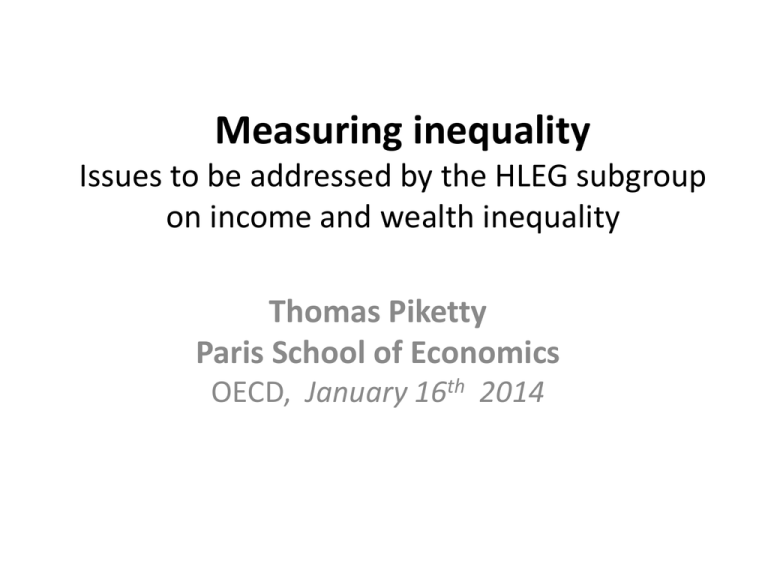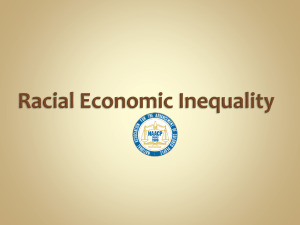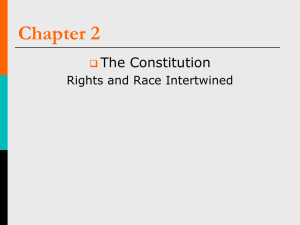ppt - Thomas Piketty
advertisement

Measuring inequality Issues to be addressed by the HLEG subgroup on income and wealth inequality Thomas Piketty Paris School of Economics OECD, January 16th 2014 • « Work under the “income and wealth inequality” theme would take stock of measurement issues on the distribution of household income and wealth, such as developments at both the top and bottom of the distribution, the relation between household income and wealth and other aspects of economic well-being (e.g. consumption), and the broad range of policy issues that better measures in this field would allow addressing » Presentation note of the High-Level Expert Group (HLEG) on the Measurement of Economic Performance and Social Progress, August 2013 • A general question that I would like to ask to the group: can we envision a realistic plan and timetable for harmonized, annual, global « distributional national accounts » (DINA) ? • The DINA agenda = take the definitions of national income and national wealth as they are (say, SNA 2008), and try to decompose aggregate income and wealth by percentile of income and wealth shares in a consistent, systematic, credible and annual manner → official, annual decompositions of growth by social groups • It will probably take a long time before we are able to develop official, consensual DINAs; for many years to come – and maybe several decades –, inequality statistics will still be produced by various groups of people – academics, statistical institutes,.. – using various sources and methods; and that is fine • But, in any case, it is useful to think about what’s missing for DINAs to exist, and about a possible plan/timetable to make progress • It took a long time (≈1910s-1950s) before scholars – Kuznets, Kendrick, Dugé.. – could hand over the computation of national income and GDP to official institutes • It also took a long time (≈1950s-2000s) before official national accounts were able to include standardized stock accounts (first consistent guidelines for balance sheets - assets and liabilities - appear in SNA 1993, 2008; in some key countries like Germany, first consistent official balance sheet released in 2010) • Maybe it will take as much time (2010s-2050s?) to develop concepts and methods for inequality measurement that are fully standardized and consistent with national accounts; but it is worth trying moving in this direction Promises and pitfalls in inequality measurement • Much progress has been made at collecting household surveys: - LIS (income surveys, 40 countries, 1968-2010) (as of Jan.15th 2014) - LWS (wealth surveys, 12 countries, 1994-2007) - WB LSMS (income/expenditure surveys, 39 countries, 1985-2012) • But these surveys are still not annual and homogenous • Also, self-reported survey data raises big problems at the top: in many countries, the richest individuals in surveys are unplausibly poor (say, <5-10 times average income), which badly hurts the credibility of official statistics in general → the growth that people see around them can sometime be very different from the growth they hear about in official GDP stats • Some limited progress has been made with the WTID: using tax data and national accounts data in a consistent manner (Kuznets 1953), annual series were constructed for top decile and percentile income shares (28 countries, 1870-2012, AtkinsonAlvaredo-Piketty-Saez and 30+ others) (see http://topincomes.parisschoolofeconomics.eu) • These top shares estimates are more credible than survey-based estimates and have contributed to reshape public debate: see US series with Saez; or Indian series with Banerjee (missing growth) • But they are still very imperfect. In particular, they are not fully consistent with national accounts. They deal with the distribution of taxable income, not national income. Missing tax exempt capital income. Missing tax exempt transfers. • Next step: combine tax and survey data and national accounts in a more systematic way (imputation methods) (on-going work on US) From income to wealth inequality • Pioneering work by Davies, Shorrocks et al, «The level and distribution of global household wealth », EJ 2011 (this pursues the work of Bourguignon, Milanovic on the global income distribution) • See also « Credit Suisse Global Wealth Reports », etc. • These reports combine survey data with national accounts, tax data and other sources (Forbes rankings etc.) in a pragmatic manner… • … maybe too pragmatic, and not sufficiently systematic: at the end of the day, Forbes-type or Credit Suisse-type top 1% wealth shares may not be more reliable than survey-based top 1% estimates • There’s a huge social demand for wealth measurement; we need to respond to it in a rigorous and systematic manner • One ought to start from national accounts: we now have consistent balance sheets for most rich countries; see recent work on national wealth/national income ratios with Zucman • The right approach to inequality measurement should: • Combine administrative fiscal data on income and wealth and self-reported survey data in a systematic, consistent and pragmatic manner, just like national accounts • Develop statistical matching techniques to create synthetic files using the relevant information from each data source • Anchor all income and wealth aggregates to national income and wealth (it is always better to make explicit assumptions about imputations than to leave them implicit = what we do implicitely when we do not anchor income and wealth aggregates) • With Saez and Zucman, we try to follow this approach to construct consistent « Distributional National Accounts » for US and France, and both for income and wealth (in-progress, 2014; = very preliminary and exploratory, to be be presented at future meetings of HLEG) • Can this be made more systematic and less exploratory?










